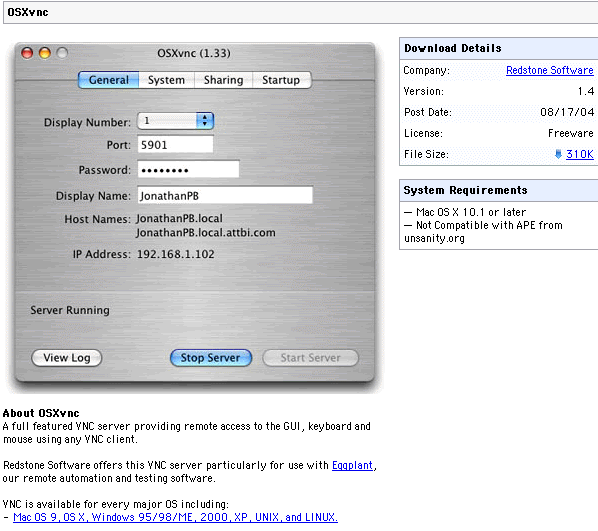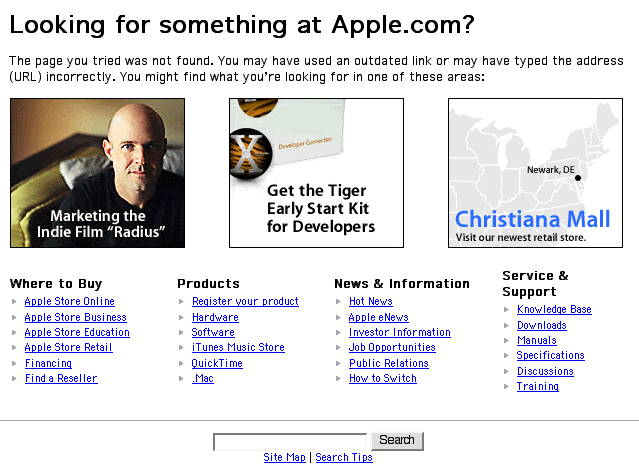Web Blooper of the Month
Broken Internal Links
How often have you clicked on a link in a website to go to another page on the site, but instead found yourself staring at a "Page not found" error screen? Unfortunately, such experiences are all too common.
I am not referring to broken off-site links. The Web changes. External pages change. If you link your website to other sites, those sites may move or disappear. Yes, you should check your site's external links periodically to make sure they still work, but ultimately, the stability of pages on other websites is out of your control.
In contrast, broken internal links -- links to other pages on your site -- are inexcusable: they show your site visitors that your website development team didn't check their work and/or doesn't maintain the site properly. They are an indication of sloppy work.
One might think broken internal links would be most common in websites of small companies and organizations. After all, they often have only a small, overworked Web staff -- sometimes just one person -- and their Web development budgets are small. However, I see broken internal links much more frequently on large corporate websites consisting of hundreds -- maybe thousands -- of pages. With all those pages, it is difficult to keep track of all the links that are affected if a page is moved or deleted. But the fact that it is difficult is no excuse.
Apple.com
One large site on which I've gotten "Page Not Found" errors more than once is Apple.com. The most recent example (Oct. 2004) was when I was looking for a download for installing VNC software for MacOS 9. The site has a VNC download page, which of course features VNC for the current OS, MacOS 10. However, the page includes a link that supposedly goes to versions for other operating systems, including MacOS 9 (see below).

Unfortunately, the link references a non-existent page. Apple's site traps the error and displays a page containing a gentle error message, a site directory, and a Search box (see below).

This is better than a plain "404 Page Not Found" error message, but discouraging nonetheless. The discouragement consists of: a) disappointment arising from believing you are very close to your goal but discovering that you are just as far from your goal as when you started, and b) annoyance at the bugginess and lack of quality of the site. Someone in this situation is very likely to just hit BACK in disgust.
Earthlink.net
The download pages at Earthlink.net also has a serious broken internal link. In Sepember 2004, Earthlink sent its customers email, saying that it was upgrading its email handling to improve its ability to block spam. The system upgrade required all customers to upgrade their email software. The email included a link to a page on their site listing versions of the upgrade for a variety of email clients. At the bottom of the page was a catch-all link for customers whose email client was none of those listed (see below).

My email client was not among those listed, so I clicked the catch-all link. Sorry: Page not found (see below). With this broken link, Earthlink put its customers in a bind: requiring them to upgrade (soon) to continue sending and receiving email, but blocking some of them from complying because of flaws in its website.

Avoiding the Blooper
Broken internal links are, first of all, a quality issue. Sites that contain lots of them exhibit poor quality. The remedy is better quality-control resources and processes. All links in a site must be checked, even -- especially -- if there are thousands of them. Expensive? Yes, but not optional.
A second cause of broken internal links is that many companies and organizations develop websites under the false assumption that a website is a one-time expense. Their management doesn't understand that developing a website requires a serious long-term committment of resources and funds for maintenance. The remedy is education, which is why I am writing about this.
I'm not suggesting that Apple and Earthlink don't understand quality-control or effective maintenance. Both companies surely do understand those issues. However, both companies' sites are so large and complex that even a slight, temporary breakdown in either quality control or maintenance can result in a significant incidence of broken internal links on their sites.
Apple's broken link to old versions of VNC isn't so bad. It of course is annoying to customers who encounter it, but: a) few will, and b) VNC isn't an Apple product anyway. On the other hand, Earthlink's broken link is very bad because it is a step in a process that Earthlink requires customers to complete. If you require customers to execute a procedure to remain customers, that procedure better work or else you risk losing -- not simply annoying -- those customers.